ESP Citroen DS4 RHD 2013.5 1.G User Guide
[x] Cancel search | Manufacturer: CITROEN, Model Year: 2013.5, Model line: DS4 RHD, Model: Citroen DS4 RHD 2013.5 1.GPages: 400, PDF Size: 31.86 MB
Page 81 of 400
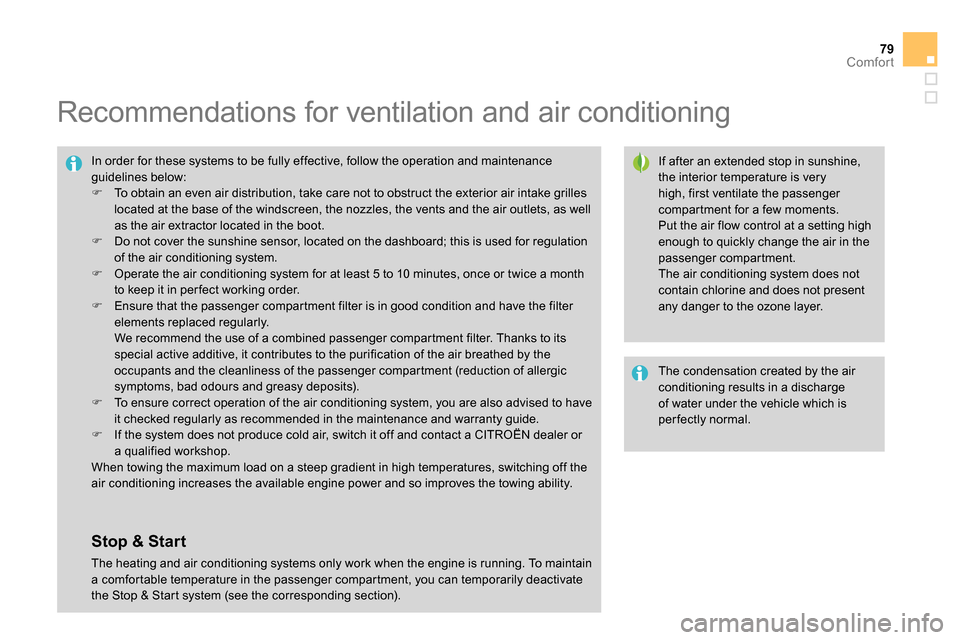
79Comfort
Recommendations for ventilation and air conditioning
If after an extended stop in sunshine,
the interior temperature is very
high, first ventilate the passenger
compartment for a few moments.
Put the air flow control at a setting high
enough to quickly change the air in the
passenger compartment.
The air conditioning system does not
contain chlorine and does not present
any danger to the ozone layer. In order for these systems to be fully effective, follow the operation and maintenance
guidelines below:
To obtain an even air distribution, take care not to obstruct the exterior air intake grilles
located at the base of the windscreen, the nozzles, the vents and the air outlets, as well
as the air extractor located in the boot.
Do not cover the sunshine sensor, located on the dashboard; this is used for regulation
of the air conditioning system.
Operate the air conditioning system for at least 5 to 10 minutes, once or twice a month
to keep it in per fect working order.
Ensure that the passenger compartment filter is in good condition and have the filter
elements replaced regularly.
We recommend the use of a combined passenger compartment filter. Thanks to its
special active additive, it contributes to the purification of the air breathed by the
occupants and the cleanliness of the passenger compartment (reduction of allergic
symptoms, bad odours and greasy deposits).
To ensure correct operation of the air conditioning system, you are also advised to have
it checked regularly as recommended in the maintenance and warranty guide.
If the system does not produce cold air, switch it off and contact a CITROËN dealer or
a qualified workshop.
When towing the maximum load on a steep gradient in high temperatures, switching off the
air conditioning increases the available engine power and so improves the towing ability.
The condensation created by the air
conditioning results in a discharge
of water under the vehicle which is
per fectly normal.
Stop & Start
The heating and air conditioning systems only work when the engine is running. To maintain
a comfortable temperature in the passenger compartment, you can temporarily deactivate
the Stop & Start system (see the corresponding section).
Page 85 of 400
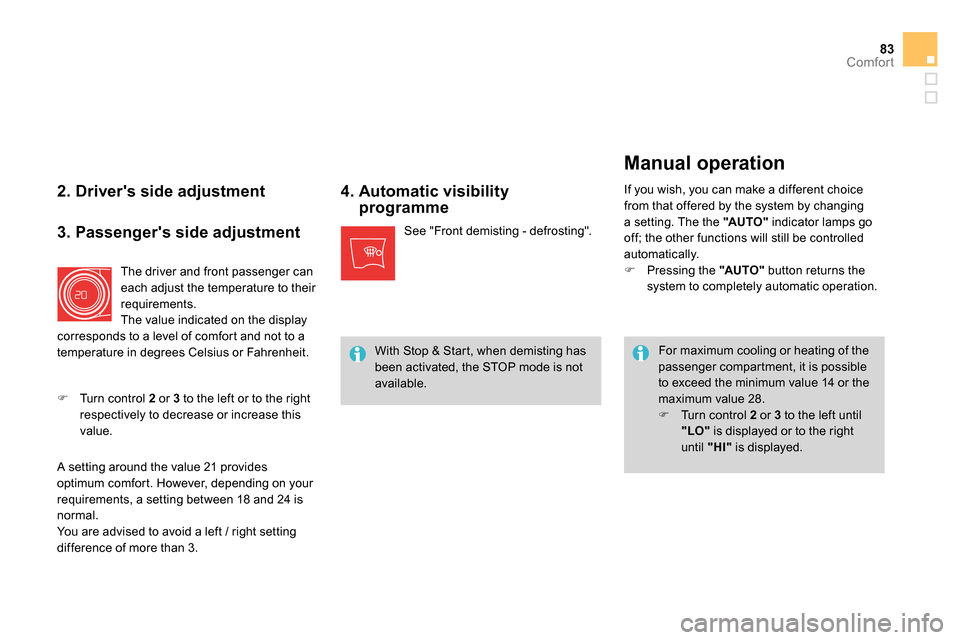
83Comfort
2. Driver's side adjustment
4. Automatic visibility
programme
For maximum cooling or heating of the
passenger compartment, it is possible
to exceed the minimum value 14 or the
maximum value 28.
Turn control 2
or 3
to the left until
"LO"
is displayed or to the right
until "HI"
is displayed. See "Front demisting - defrosting".
3. Passenger's side adjustment
The driver and front passenger can
each adjust the temperature to their
requirements.
The value indicated on the display
corresponds to a level of comfort and not to a
temperature in degrees Celsius or Fahrenheit.
Turn control 2
or 3
to the left or to the right
respectively to decrease or increase this
value.
A setting around the value 21 provides
optimum comfort. However, depending on your
requirements, a setting between 18 and 24 is
normal.
You are advised to avoid a left / right setting
difference of more than 3.
Manual operation
If you wish, you can make a different choice
from that offered by the system by changing
a setting. The the "AUTO "
indicator lamps go
off; the other functions will still be controlled
automatically.
Pressing the "AUTO "
button returns the
system to completely automatic operation.
With Stop & Start, when demisting has
been activated, the STOP mode is not
available.
Page 94 of 400
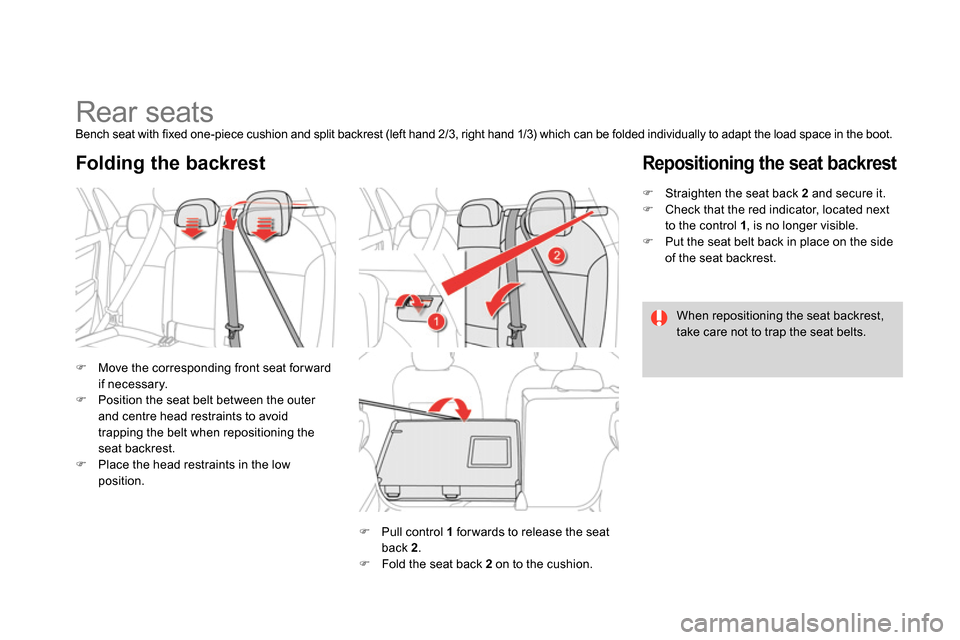
Rear seats
Bench seat with fixed one-piece cushion and split backrest (left hand 2/3, right hand 1/3) which can be folded individually to adapt the load space in the boot.
Move the corresponding front seat for ward
if necessary.
Position the seat belt between the outer
and centre head restraints to avoid
trapping the belt when repositioning the
seat backrest.
Place the head restraints in the low
position.
Folding the backrest
Pull control 1
for wards to release the seat
back 2
.
Fold the seat back 2
on to the cushion.
Straighten the seat back 2
and secure it.
Check that the red indicator, located next
to the control 1
, is no longer visible.
Put the seat belt back in place on the side
of the seat backrest.
Repositioning the seat backrest
When repositioning the seat backrest,
take care not to trap the seat belts.
Page 96 of 400

Mirrors
Each fitted with an adjustable mirror glass
permitting the lateral rear ward vision necessary
for overtaking or parking. They can also be
folded for parking in confined spaces.
Demisting - Defrosting
Adjustment
Move control A
to the right or to the left to
select the corresponding mirror.
Move control B
in all four directions to
adjust.
Return control A
to the central position.
Door mirrors
The objects obser ved are, in reality,
closer than they appear.
Take this into account in order to
correctly judge the distance of vehicles
approaching from behind.
Folding
From outside: lock the vehicle using
the remote control or the key.
From inside: with the ignition on, pull the
control A
in the central position rear wards.
Unfolding
From outside: unlock the vehicle using
the remote control or the key.
From inside: with the ignition on, pull the
control A
in the central position rear wards. If the mirrors are folded using control A
,
they will not unfold when the vehicle is
unlocked. Pull again on control A
.
The folding and unfolding of the door
mirrors using the remote control can be
deactivated by a CITROËN dealer or a
qualified workshop.
Never fold or unfold the electric folding
mirrors manually.
If your vehicle is fitted with heated
mirrors, the demisting-defrosting
operates by switching on the heated
rear screen (refer to the "Rear screen
demist-defrost" page).
The rear screen demist - defrost can only
operate when the engine is running.
Page 97 of 400

95Comfort
Automatic tilting in reverse gear
System which provides a view of the ground
during parking manoeuvres in reverse gear.
Programming
With the engine running, engage reverse
gear.
Select and adjust the left-hand and right-
hand mirrors in succession.
The adjustment is stored immediately.
Switching on
With the engine running, engage reverse
gear.
Move control A
to the right or to the left to
select the corresponding mirror.
The glass of the mirror selected tilts
downwards, in accordance with its
programming.
Switching off
Exit reverse gear and wait ten seconds.
or
Return control A
to the central position.
The mirror glass returns to its initial position.
The mirror glass also returns to its initial
position:
- if the speed exceeds 6 mph (10 km/h),
- if the engine is switched off.
Page 111 of 400
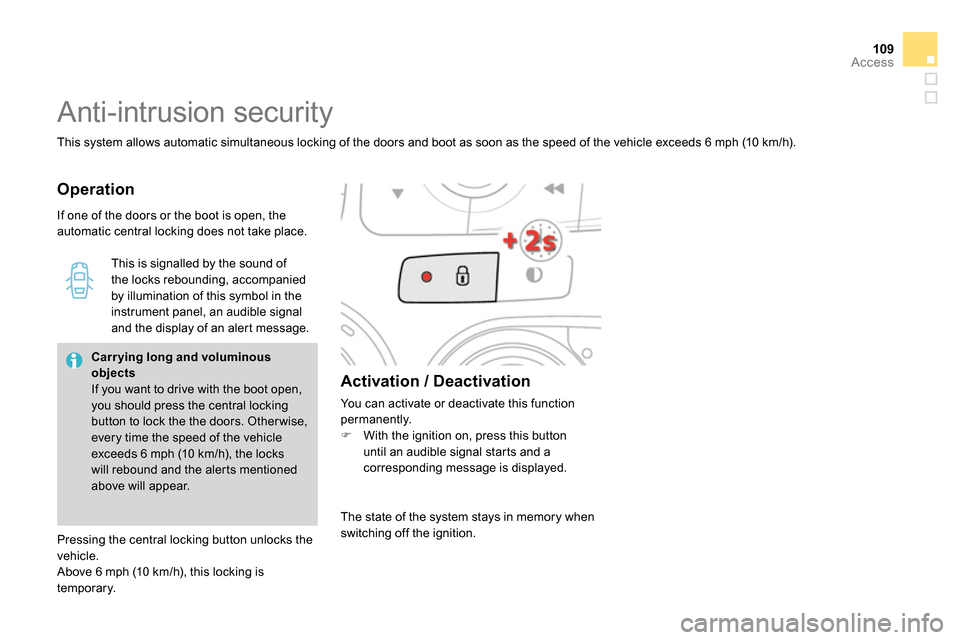
109Access
This system allows automatic simultaneous locking of the doors and boot as soon as the speed of the vehicle exceeds 6 mph (10 km/h).
Anti-intrusion security
Operation
Activation / Deactivation
You can activate or deactivate this function
permanently.
With the ignition on, press this button
until an audible signal starts and a
corresponding message is displayed. If one of the doors or the boot is open, the
automatic central locking does not take place.
This is signalled by the sound of
the locks rebounding, accompanied
by illumination of this symbol in the
instrument panel, an audible signal
and the display of an alert message.
Carr ying long and voluminous
objects
If you want to drive with the boot open,
you should press the central locking
button to lock the the doors. Other wise,
every time the speed of the vehicle
exceeds 6 mph (10 km/h), the locks
will rebound and the alerts mentioned
above will appear.
Pressing the central locking button unlocks the
vehicle.
Above 6 mph (10 km/h), this locking is
temporary. The state of the system stays in memory when
switching off the ignition.
Page 116 of 400
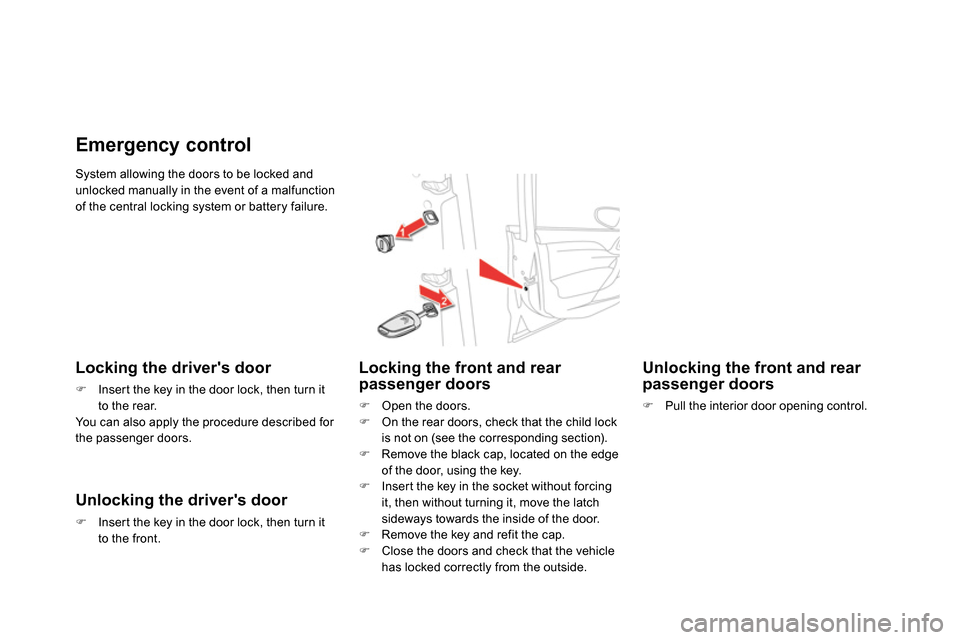
System allowing the doors to be locked and
unlocked manually in the event of a malfunction
of the central locking system or battery failure.
Emergency control
Locking the driver's door
Insert the key in the door lock, then turn it
to the rear.
You can also apply the procedure described for
the passenger doors.
Unlocking the driver's door
Insert the key in the door lock, then turn it
to the front.
Locking the front and rear
passenger doors
Open the doors.
On the rear doors, check that the child lock
is not on (see the corresponding section).
Remove the black cap, located on the edge
of the door, using the key.
Insert the key in the socket without forcing
it, then without turning it, move the latch
sideways towards the inside of the door.
Remove the key and refit the cap.
Close the doors and check that the vehicle
has locked correctly from the outside.
Unlocking the front and rear
passenger doors
Pull the interior door opening control.
Page 127 of 400
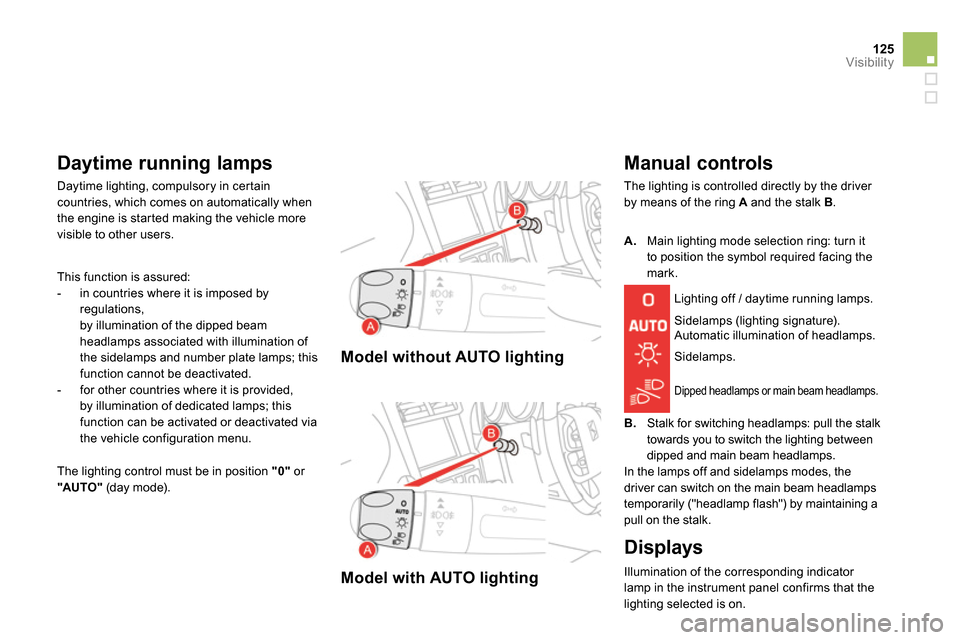
125Visibility
Model without AUTO lighting
Model with AUTO lighting
Manual controls
The lighting is controlled directly by the driver
by means of the ring A
and the stalk B
.
Sidelamps (lighting signature).
Automatic illumination of headlamps.
B.
Stalk for switching headlamps: pull the stalk
towards you to switch the lighting between
dipped and main beam headlamps.
In the lamps off and sidelamps modes, the
driver can switch on the main beam headlamps
temporarily ("headlamp flash") by maintaining a
pull on the stalk.
A.
Main lighting mode selection ring: turn it
to position the symbol required facing the
mark.
Lighting off / daytime running lamps.
Sidelamps.
Dipped headlamps or main beam headlamps.
Displays
Illumination of the corresponding indicator
lamp in the instrument panel confirms that the
lighting selected is on. Daytime lighting, compulsory in certain
countries, which comes on automatically when
the engine is started making the vehicle more
visible to other users.
This function is assured:
- in countries where it is imposed by
regulations,
by illumination of the dipped beam
headlamps associated with illumination of
the sidelamps and number plate lamps; this
function cannot be deactivated.
- for other countries where it is provided,
by illumination of dedicated lamps; this
function can be activated or deactivated via
the vehicle configuration menu.
Daytime running lamps
The lighting control must be in position "0"
or
"AUTO "
(day mode).
Page 129 of 400

127Visibility
Switching off the lighting
when switching off the ignition
When the ignition is switched off, all
of the lamps switch off immediately,
except for the dipped beam headlamps
if automatic guide-me-home lighting is
activated.
The temporary illumination of the dipped beam
headlamps after the vehicle's ignition has been
switched off makes the driver's exit easier
when the light is poor.
Switching on
With the ignition off, "flash" the headlamps
using the lighting stalk.
A further "headlamp flash" switches the
function off.
Switching off
The manual guide-me-home lighting switches
off automatically after a set time.
Manual guide-me-home
lighting
Switching on the lighting when
switching on the ignition
To reactivate the lighting control stalk, turn
the ring A
to position "0"
- lighting off, then
to the position of your choice.
If the lighting is switched on manually after
switching off the ignition, there is an audible
signal when a front door is opened to warn
the driver that they have forgotten to switch
off the vehicle's lighting, with the ignition off.
They switch off automatically after a period
which depends on the state of charge of the
battery (entry to energy economy mode).
Parking lamps
Side markers for the vehicle by illumination of
the sidelamps on the traffic side only.
Within one minute of switching off the
ignition, operate the lighting control stalk
up or down depending on the traffic side
(for example: when parking on the left;
lighting control stalk upwards; the right
hand sidelamps are on).
This is confirmed by an audible signal and
illumination of the corresponding direction
indicator warning lamp in the instrument panel.
To switch off the parking lamps, return the
lighting control stalk to the central position.
Page 134 of 400
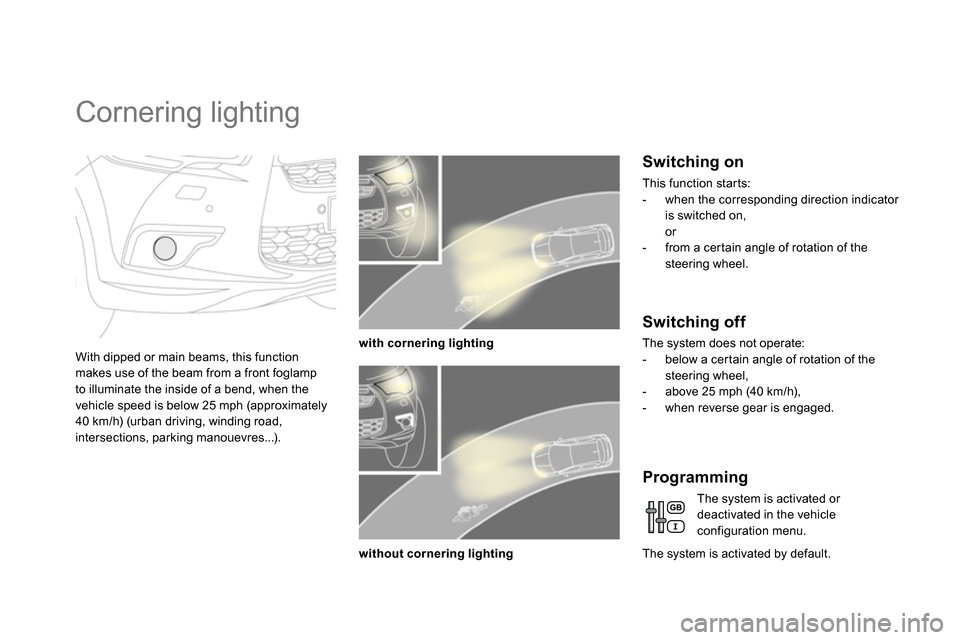
Cornering lighting
With dipped or main beams, this function
makes use of the beam from a front foglamp
to illuminate the inside of a bend, when the
vehicle speed is below 25 mph (approximately
40 km/h) (urban driving, winding road,
intersections, parking manouevres...).
Switching on
with cornering lighting
without cornering lighting
Switching off
The system does not operate:
- below a certain angle of rotation of the
steering wheel,
- above 25 mph (40 km/h),
- when reverse gear is engaged.
The system is activated by default.
Programming
The system is activated or
deactivated in the vehicle
configuration menu. This function starts:
- when the corresponding direction indicator
is switched on,
or
- from a certain angle of rotation of the
steering wheel.